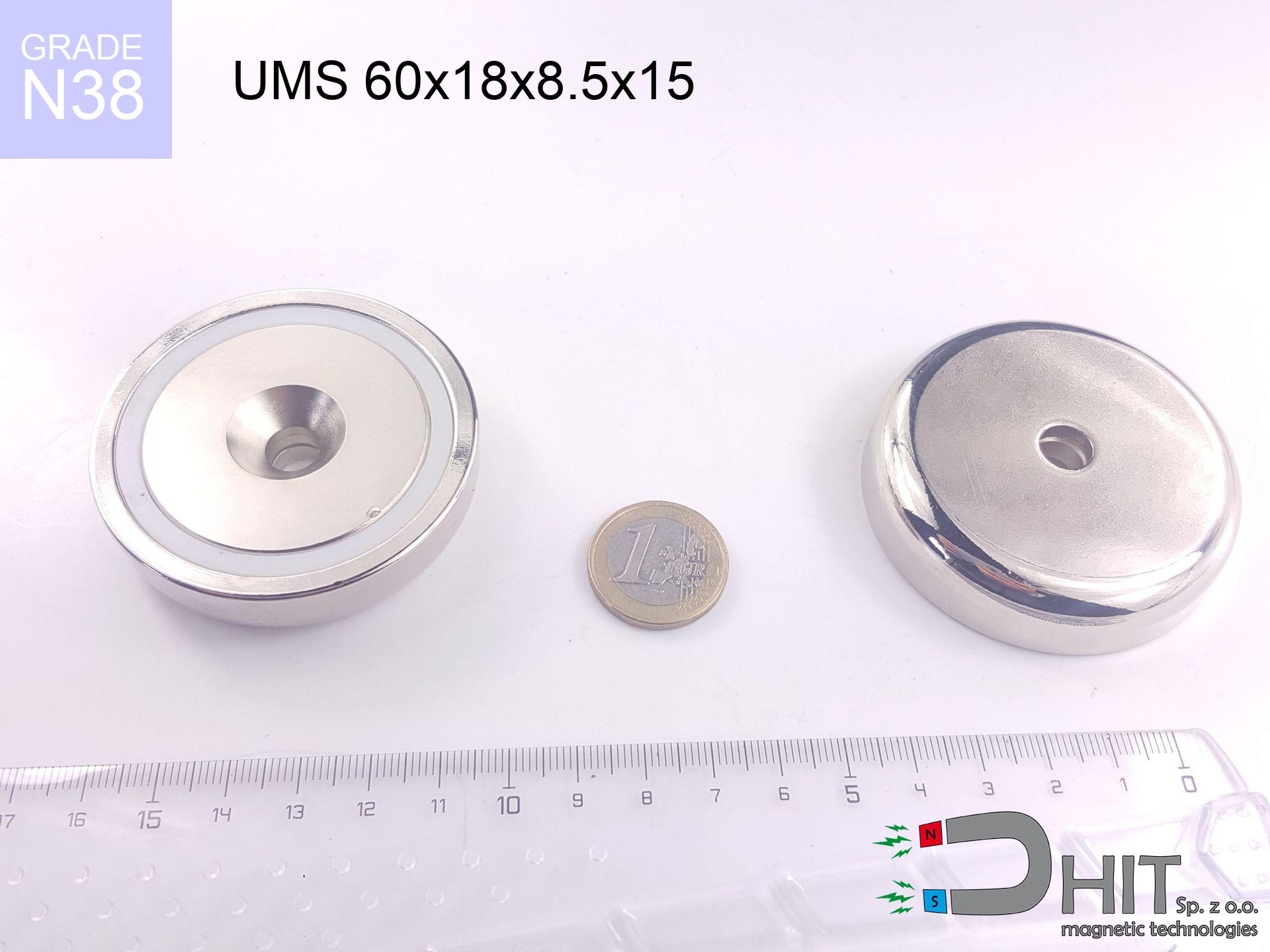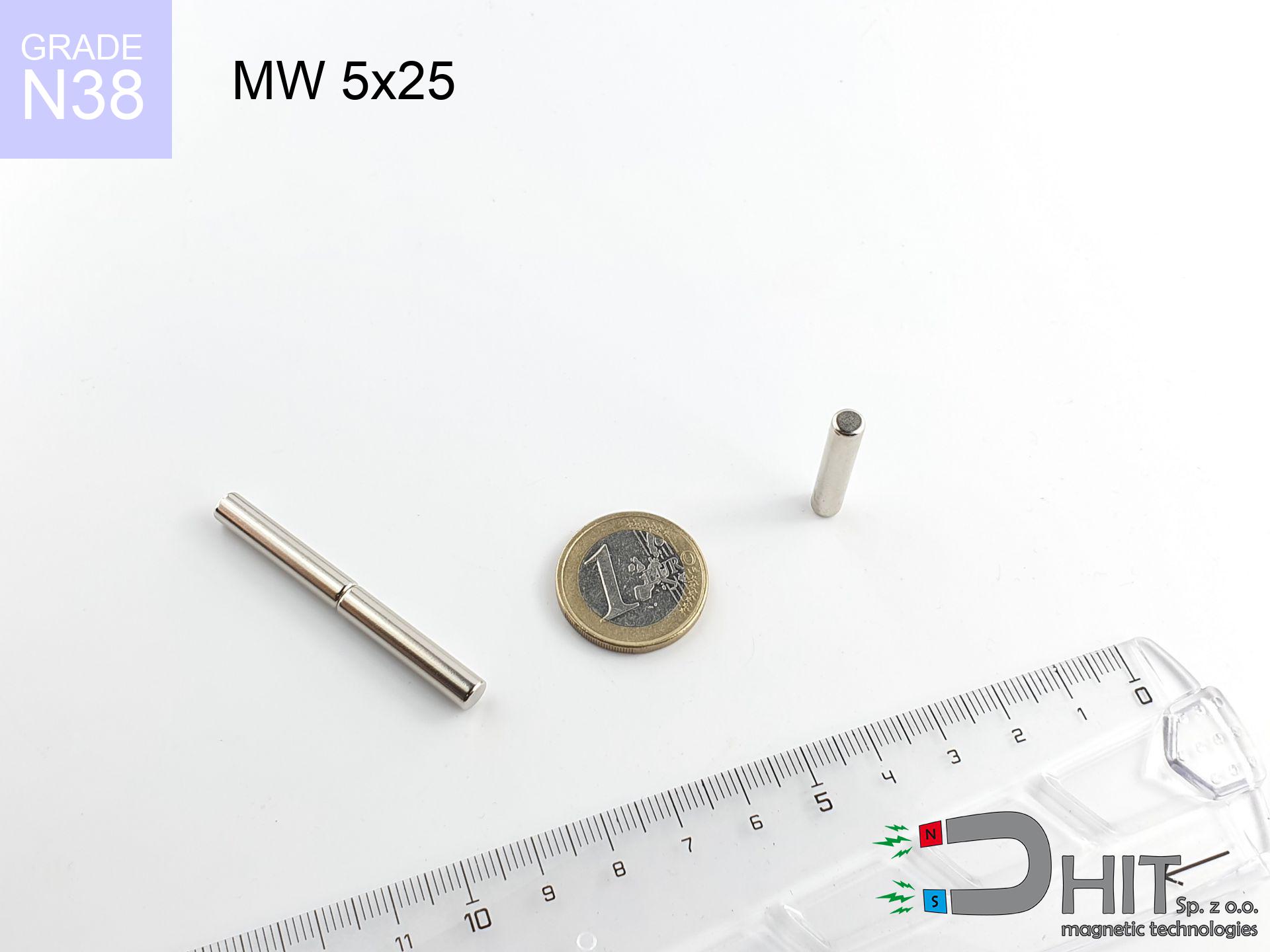UMS 60x18x8.5x15 / N38 - conical magnetic holder
conical magnetic holder
Catalog no 220404
GTIN/EAN: 5906301814238
Diameter Ø
60 mm [±1 mm]
cone dimension Ø
18x8.5 mm [±1 mm]
Height
15 mm [±1 mm]
Weight
250 g
Magnetization Direction
↑ axial
Load capacity
112.00 kg / 1098.34 N
Coating
[NiCuNi] Nickel
62.78 ZŁ with VAT / pcs + price for transport
51.04 ZŁ net + 23% VAT / pcs
bulk discounts:
Need more?
Contact us by phone
+48 22 499 98 98
if you prefer let us know using
our online form
the contact form page.
Specifications as well as appearance of magnetic components can be checked on our
power calculator.
Orders placed before 14:00 will be shipped the same business day.
Technical details - UMS 60x18x8.5x15 / N38 - conical magnetic holder
Specification / characteristics - UMS 60x18x8.5x15 / N38 - conical magnetic holder
| properties | values |
|---|---|
| Cat. no. | 220404 |
| GTIN/EAN | 5906301814238 |
| Production/Distribution | Dhit sp. z o.o. |
| Country of origin | Poland / China / Germany |
| Customs code | 85059029 |
| Diameter Ø | 60 mm [±1 mm] |
| cone dimension Ø | 18x8.5 mm [±1 mm] |
| Height | 15 mm [±1 mm] |
| Weight | 250 g |
| Magnetization Direction | ↑ axial |
| Load capacity ~ ? | 112.00 kg / 1098.34 N |
| Coating | [NiCuNi] Nickel |
| Manufacturing Tolerance | ±1 mm |
Magnetic properties of material N38
| properties | values | units |
|---|---|---|
| remenance Br [min. - max.] ? | 12.2-12.6 | kGs |
| remenance Br [min. - max.] ? | 1220-1260 | mT |
| coercivity bHc ? | 10.8-11.5 | kOe |
| coercivity bHc ? | 860-915 | kA/m |
| actual internal force iHc | ≥ 12 | kOe |
| actual internal force iHc | ≥ 955 | kA/m |
| energy density [min. - max.] ? | 36-38 | BH max MGOe |
| energy density [min. - max.] ? | 287-303 | BH max KJ/m |
| max. temperature ? | ≤ 80 | °C |
Physical properties of sintered neodymium magnets Nd2Fe14B at 20°C
| properties | values | units |
|---|---|---|
| Vickers hardness | ≥550 | Hv |
| Density | ≥7.4 | g/cm3 |
| Curie Temperature TC | 312 - 380 | °C |
| Curie Temperature TF | 593 - 716 | °F |
| Specific resistance | 150 | μΩ⋅cm |
| Bending strength | 250 | MPa |
| Compressive strength | 1000~1100 | MPa |
| Thermal expansion parallel (∥) to orientation (M) | (3-4) x 10-6 | °C-1 |
| Thermal expansion perpendicular (⊥) to orientation (M) | -(1-3) x 10-6 | °C-1 |
| Young's modulus | 1.7 x 104 | kg/mm² |
Elemental analysis
| iron (Fe) | 64% – 68% |
| neodymium (Nd) | 29% – 32% |
| boron (B) | 1.1% – 1.2% |
| dysprosium (Dy) | 0.5% – 2.0% |
| coating (Ni-Cu-Ni) | < 0.05% |
Sustainability
| recyclability (EoL) | 100% |
| recycled raw materials | ~10% (pre-cons) |
| carbon footprint | low / zredukowany |
| waste code (EWC) | 16 02 16 |
View also products
Advantages as well as disadvantages of Nd2Fe14B magnets.
Benefits
- They do not lose magnetism, even after nearly 10 years – the reduction in lifting capacity is only ~1% (theoretically),
- They feature excellent resistance to magnetic field loss as a result of external magnetic sources,
- In other words, due to the glossy surface of gold, the element looks attractive,
- They feature high magnetic induction at the operating surface, which improves attraction properties,
- Neodymium magnets are characterized by very high magnetic induction on the magnet surface and can function (depending on the shape) even at a temperature of 230°C or more...
- Thanks to freedom in designing and the ability to adapt to specific needs,
- Huge importance in innovative solutions – they serve a role in hard drives, electric motors, advanced medical instruments, as well as other advanced devices.
- Thanks to concentrated force, small magnets offer high operating force, in miniature format,
Disadvantages
- Susceptibility to cracking is one of their disadvantages. Upon strong impact they can break. We advise keeping them in a special holder, which not only secures them against impacts but also increases their durability
- Neodymium magnets lose their power under the influence of heating. As soon as 80°C is exceeded, many of them start losing their force. Therefore, we recommend our special magnets marked [AH], which maintain durability even at temperatures up to 230°C
- They oxidize in a humid environment - during use outdoors we recommend using waterproof magnets e.g. in rubber, plastic
- We recommend a housing - magnetic mount, due to difficulties in producing threads inside the magnet and complicated shapes.
- Health risk to health – tiny shards of magnets pose a threat, if swallowed, which gains importance in the context of child safety. It is also worth noting that small elements of these products are able to disrupt the diagnostic process medical when they are in the body.
- With large orders the cost of neodymium magnets is a challenge,
Pull force analysis
Breakaway strength of the magnet in ideal conditions – what it depends on?
- on a block made of structural steel, perfectly concentrating the magnetic flux
- with a cross-section of at least 10 mm
- with an polished touching surface
- without any clearance between the magnet and steel
- during pulling in a direction vertical to the mounting surface
- at temperature room level
Lifting capacity in real conditions – factors
- Clearance – existence of foreign body (paint, tape, air) acts as an insulator, which reduces power rapidly (even by 50% at 0.5 mm).
- Force direction – note that the magnet holds strongest perpendicularly. Under shear forces, the holding force drops significantly, often to levels of 20-30% of the maximum value.
- Steel thickness – insufficiently thick plate does not accept the full field, causing part of the flux to be wasted to the other side.
- Metal type – not every steel attracts identically. Alloy additives weaken the interaction with the magnet.
- Surface condition – smooth surfaces guarantee perfect abutment, which improves force. Rough surfaces reduce efficiency.
- Temperature influence – hot environment reduces magnetic field. Too high temperature can permanently demagnetize the magnet.
Holding force was checked on the plate surface of 20 mm thickness, when the force acted perpendicularly, whereas under shearing force the lifting capacity is smaller. Moreover, even a minimal clearance between the magnet’s surface and the plate lowers the lifting capacity.
H&S for magnets
Do not drill into magnets
Machining of neodymium magnets poses a fire risk. Neodymium dust reacts violently with oxygen and is difficult to extinguish.
Heat sensitivity
Do not overheat. NdFeB magnets are susceptible to temperature. If you require resistance above 80°C, look for HT versions (H, SH, UH).
Fragile material
Despite metallic appearance, neodymium is delicate and not impact-resistant. Avoid impacts, as the magnet may shatter into hazardous fragments.
Implant safety
Warning for patients: Powerful magnets disrupt medical devices. Keep minimum 30 cm distance or ask another person to handle the magnets.
Serious injuries
Danger of trauma: The attraction force is so immense that it can cause hematomas, pinching, and even bone fractures. Protective gloves are recommended.
Threat to navigation
Note: rare earth magnets generate a field that confuses precision electronics. Keep a safe distance from your mobile, device, and GPS.
Threat to electronics
Powerful magnetic fields can destroy records on credit cards, hard drives, and storage devices. Maintain a gap of min. 10 cm.
Safe operation
Exercise caution. Neodymium magnets attract from a distance and connect with massive power, often quicker than you can move away.
Allergic reactions
Some people experience a contact allergy to nickel, which is the standard coating for NdFeB magnets. Frequent touching might lead to dermatitis. We suggest use safety gloves.
No play value
Neodymium magnets are not toys. Swallowing multiple magnets can lead to them connecting inside the digestive tract, which poses a severe health hazard and necessitates immediate surgery.







![SM 25x175 [2xM8] / N52 - magnetic separator SM 25x175 [2xM8] / N52 - magnetic separator](https://cdn3.dhit.pl/graphics/products/sm-25x175-2xm8-gif.jpg)

